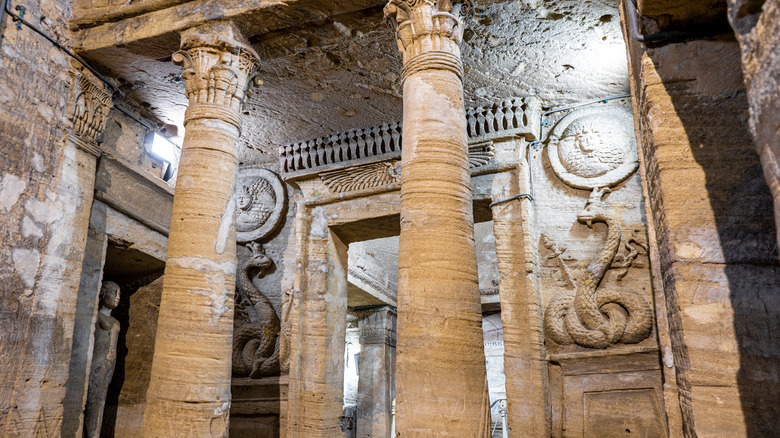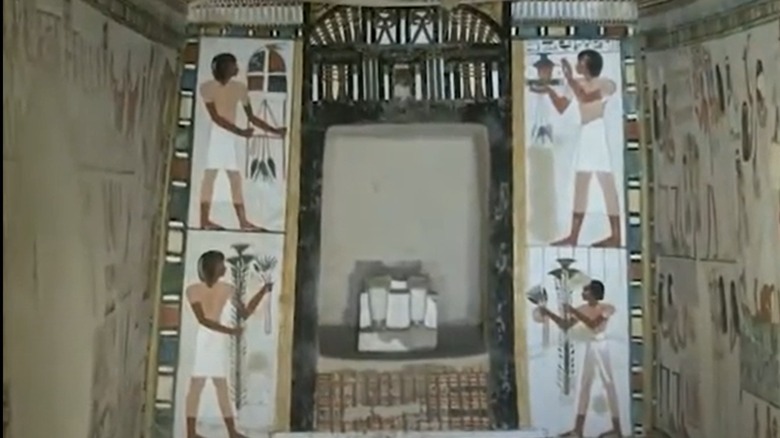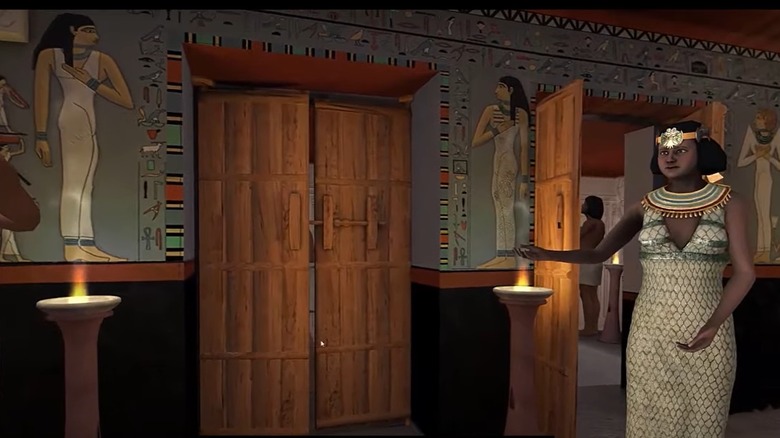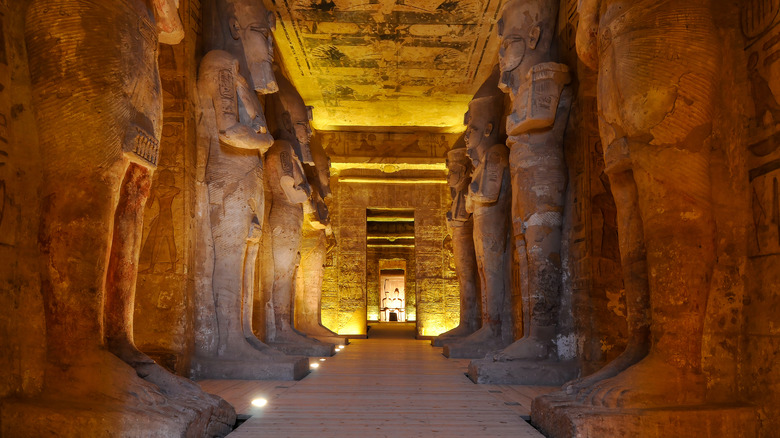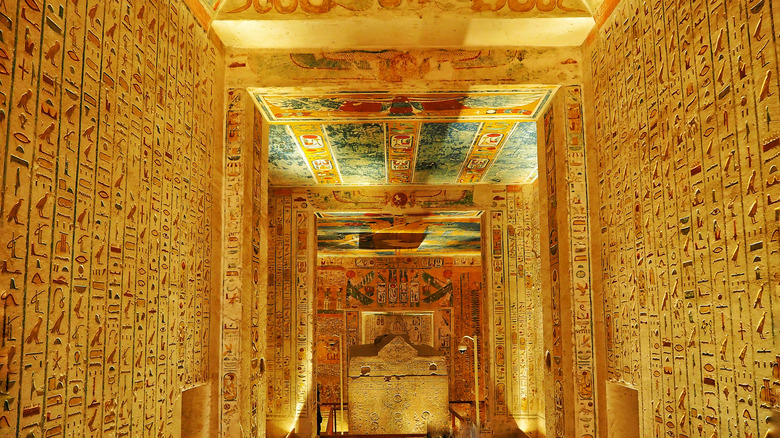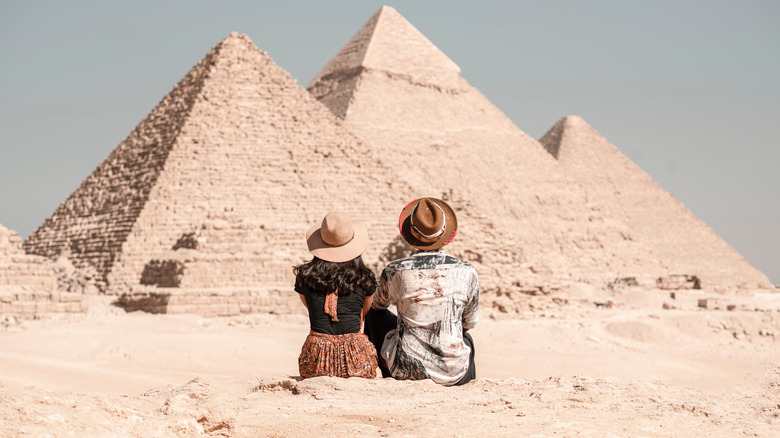This Is What The Inside Of A Pharaoh's Tomb Actually Looks Like
Tombs and other ancient burial systems are vital pieces of history. Not only do they tell us a great deal about how people of the past died, but perhaps more importantly, these ancient relics speak volumes about the way they lived (via The Met Museum).
For years, if you wanted to view burial chambers from the past, particularly large models like the ancient Egyptian tombs situated in grandiose pyramids, you had to travel overseas for a tour. Of course, staring at ancient artifacts from behind the glass at your local museum was a close second. Both of these options paint a vivid but limited portrait, like peering through a peephole into an ancient world.
Now, according to My Modern Met, there's a new virtual way to tour ancient Egyptian tombs from the comfort of your own home. This type of tour features a 360 glimpse at the writings on the wall as well as the artifacts stored inside. Here's a look at the brave new take on digital tourism and how it might change the future of historical archiving, forever.
Virtual tour of the tomb of Menna
Thanks to the digital craftsmanship of ARCE with Egypt's Ministry of Tourism and Antiquities, history buffs and novices alike can enter into a realm that existed more than 3,000 years ago. The virtual tour of the tomb of Menna is an enlightening sight accessible to just about everyone with a computer, tablet, smartphone, or laptop (via My Matterport).
The tour begins at the west bank of Luxor where the ancient Thebes' prime cemetery is located. This region has been deemed a "necropolis" because it is absolutely brimming with sealed Egyptian coffins (via CBS News Chicago). As the tour progresses, virtual viewers are guided down a narrow ramp and into the ancient tomb. The art on the walls depicts Menna overseeing the fields beneath a vibrantly colored ceiling painted in a repetitive zig-zag pattern. His wife Henuttawy and children Amenemweskhet, Kasy, Nehemet, Se, and Kha are also depicted engaging in various spiritual rituals in murals on the wall.
The hall gives way to a shrine where a crumbling statue that once portrayed Menna and Henuttawy now stands reduced to just two sets of legs. Here, eager history enthusiasts can take in one of the most iconic murals uncovered to date. It is the scene known as "The Weighing of the Heart" portraying Menna and his deeds being weighed on the Day of Judgment.
Virtual tour of the tomb of Queen Meresankh III
The digital display of the tomb of Queen Meresankh III was presented by the Ministry of Tourism and Antiques in collaboration with the Giza Project, as My Matterport explains. Here, the light filters in from the doorway, casting shadows on elaborately decorated walls. Virtual visitors get a 360-degree look at the false door intricately carved from stone along the wall, onto which the sun's rays would fall at certain times of the day.
One of the many brightly-colored portraits adorning the walls depicts Queen Meresankh III and her mother, Queen Hetepheres II sailing the shimmering waters of the Nile together collecting offerings for their deities. The far-right wall features intricate carvings of 10 statues representing some powerful women of Giza. Given the patriarchal influence on ancient Egypt, this type of structure is believed to be somewhat uncommon.
According to The Giza Project at Harvard University, Queen Meresankh III was the granddaughter of King Khufu, whose claim to fame was constructing the Great Pyramid at Giza. This could explain why her ranking was exalted enough to warrant a statue.
Virtual tour of the tomb of Wahtye
The tomb of Wahtye was unearthed recently in 2018. It belonged to the fifth dynasty high priest Wahtye who was not a pharaoh but an individual of relatively high social status (per World Archaeology). His tomb is considered one of the greatest Old Kingdom tombs in Saqqara, which is near a hallowed animal burial site.
Virtual visitors who scroll over this tomb can engage with interactive 3D models depicting the life and times of this high-ranking nobleman who lived around 2450 B.C. (via Virtual Reality Travel). Statues align the walls, each revealing a different pose used to portray the highly regarded Wahtye. They lead to the infamous window into the "serdab," which is a secret chamber where a statue was often placed. Much like the aforementioned queen's tomb, Wahtye's final resting place was also fitted with a famous false door, a kind of symbolic depiction meant to represent the passing of the soul.
Behind the sites and scenes of interactive 3D rendering
Inside the tombs of ancient royals, we find many repetitive patterns. Common components include mysterious hieroglyphics, meticulously crafted statues, long, narrow corridors, false doors, title descriptions, sarcophagi, and murals depicting ancient spiritual rituals. These themes, while common, are being viewed differently thanks in large part to the modern practice of interactive 3D rendering.
According to Smithsonian Magazine, virtual tours that develop from 3D renderings are unlike video footage and other virtual media in that these tours rely on 3-dimensional models. Perusing a tomb at the click of a mouse may lack the allure of an in-person viewing, however, it also has advantages. Scrolling, rather than strolling gives viewers access to informative blurbs hovering over each image. This is not to mention the convenience of seeing these sites from the safety of home and avoiding an associated entry fee or, in many cases, a plane ticket purchase.
In an interview with Al-Monitor, a spokesperson for the Egyptian Tourism and Antiquities Ministry said that the tours "serve the double purpose of promoting Egyptian tourism nationwide and increasing Egyptians' awareness of their own civilization."
How COVID-19 altered the future of history
The boost in virtual travel is largely attributed to the pandemic as National Geographic reports. As tourism analyst Ralph Hollister explained, "the impact of COVID-19 may allow [virtual reality] to shake off its image of being a gimmick."
This could mean that the rise in virtual tourist sites is a trend here to stay that will keep us on the go. Discovering the relics and ruins of the distant past while learning about regions of the world we've never seen in person is suddenly as simple as opening a new tab (via Smithsonian Magazine). Perhaps this new innovative way of studying the past speaks volumes about our own futures as well.
From the tombs of pharaohs to the banks of Luxor, virtual reality is not only changing the way we see ancient sites, but is also altering the future of history as we know it. Whether these technological advancements are a window into new adventures or a false door leading to a dead-end remains to be seen.
